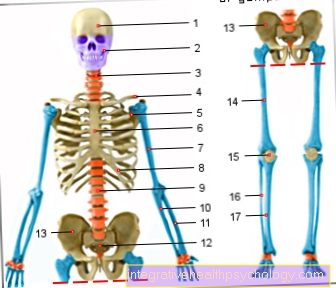Ergometry
Synonyms: stress test
English: ergometry
definition

The term ergometry comes from ancient Greek: "Érgon" stands for work and "Métron" for measure, which in the end means something like work measurement / stress measurement.
It is used to assess the cardiovascular system and consequently also the physical performance and fitness level of a person in a standardized manner. The physiological parameters that change under physical strain are recorded with the help of an ergometer. These are the pulse, the blood pressure, the EKG lead for assessing the electrical activity of the heart, the respiratory rate, the minute ventilation, the oxygen concentration and the concentration of carbon dioxide in the exhaled air and the mechanical performance that was performed.
Numerous other variables can be derived from these values, which allow the treating person to classify the state of health of a patient and possibly to find a cause for existing complaints. Statements can also be made to estimate risk and prognosis.
Ergometry is a fairly simple procedure. Nevertheless, it provides important information about a patient, which is also particularly useful for monitoring the progress. It is an integral part of some medical examinations, especially at the cardiologist (heart specialist), pulmonologist (lung specialist), sports medicine specialist or even at the family doctor.But ergometry is also regularly encountered in the context of physiotherapy or recovery treatment (rehabilitation measure) or during training. Ergometry is therefore a widely used procedure.
Read more on the topic: Sports medical examination methods
Ergometer
This is a device for diagnostics in ergometry. There are tons of different devices to choose from that can be used individually. The standard ergometers that are most widely used are certainly the ones Exercise bike. There are two versions of this, either in Lie, so-called recumbent bikes, or in Sit. Accordingly, the ergometry devices can be adapted to the needs of the patient. For example, the lying version is suitable for people with back problems, because the ergometry should not represent any additional stress for the test subjects, but only record performance. They can be braked either mechanically or electrically and independently of the speed. They are easy to use and an obstacle that can be easily overcome for many patients when it comes to the effort required. Thus, a wide range of patients can be covered by the ergometry. This is especially useful for those who are active in sports Treadmill ergometer at or according to sport, for example a Rowing ergometer. In addition, there is an ergometer for almost every kind of requirement, including one Hand crank ergometer.
To increase the load, the number of revolutions per minute or the number of watts are increased on the bicycle ergometer. With the treadmill they can Treadmill speed or the Treadmill incline changed accordingly.
Of the 6-minute walk test represents an alternative for patients who have a reduced performance of the left ventricle and can therefore neither use the bicycle nor the treadmill ergometer. A walkway at ground level is selected (e.g. a hallway) that the patient should walk for six minutes. After the time has elapsed, the length of the route and the patient's condition are assessed.
indication
Ergometry is used both in healthy people and in sick patients. Be there health status, Resilience (subjective) and Efficiency (lens) judged. The resilience is understood as the highest possible load level that the test person can achieve on the ergometer.
In addition, the ergometry Training recommendations can be derived for practice.
Indicators for an ergometry are the Diagnosis, the Therapy monitoring and the Forecast estimation.
- Diagnosis: It relates to the assessment of the functional condition, fitness for sport, partly for scientific purposes and the search for latent diseases.
- Therapy monitoring: Here are the controls for taking medication, for rehabilitation measures (e.g. after Heart attack) and after intervention measures (e.g. heart operations) in the foreground.
- Forecast estimation: to assess Ischemia or the likelihood of possible coronary Heart disease in the presence of risk factors (e.g. high blood pressure)
What is being measured?
The ergometry records the following data:
- Heart rate
- Blood pressure
- Exercise ECG
- Respiratory rate
- Minute ventilation
- Oxygen concentration
- Carbon dioxide concentration
- subjective sense of achievement
- achieved performance (mostly in watts or km / h)
Beyond that hemodynamic (Blood vessels), pulmonary (lung) and metabolic (Metabolism) parameters determined.
An additional measurement of the breathing gases (Spiroergometry) allows insight into the processes of energy metabolism.
procedure
Before each exercise test, the patient should be examined and asked about current symptoms. It should mainly focus on heart and lung Care must be taken to rule out possible previous illnesses that do not allow an ergometric examination. Furthermore, it makes sense after the Medication (for example Beta blockers) of the patient, as this could influence the result of the ergometry in both positive and negative ways. Also the determination of size, gender and Age is important for the subsequent evaluation.
Before the stress test starts, you should do it again under resting conditions EKG written and the Blood pressure be measured. This gives an initial value for comparison with the newly determined values. The examination conditions are just as crucial. A Room temperature between 18 and 22 ° C is desirable. Also the humidity shouldn't be too high. In addition, it should be ensured that the doctor and / or the staff performing the ergometry can intervene and act in an emergency.
Now the patient is provided with all necessary means to monitor the individual values. These include a 12-lead ECG (includes Chest wall and arm and leg leads), one Blood pressure cuff and optionally one Breathing maskthat is capturing the Lung function, the so-called Spiroergometry (i.e. tidal volume, respiratory rate, etc.) is used.
In the course of the examination there are basically two different approaches to performing an ergometry. For one thing, you can have a Continuous load at a constant level aim at which a certain power (in watts) is specified for a certain time, which is ended after successful achievement. On the other hand, starting from a certain load, this can be done gradually at regular intervals increase, until the Continuous output limit of the patient is reached. This corresponds to the exhaustion of the patient.
Usually you start here at 25 or 50 watts and increase the power by 25 watts every two minutes. For very sporty subjects, it can also be increased to 50 watts every three minutes. By and large, the Total exercise duration 12 minutes do not exceed. The maximum limit for the pulse is calculated from the formula “220 - age” and should not be exceeded during the stress test.
The procedure for treadmill ergometry is slightly different. Here you start with a rest phase of three minutes and increase the load in eight steps every three minutes with increasing speed and / or greater angle of inclination.
Before, during and after exercise, attention should be paid to the following changes in the patient: the Skin color of the patient, his Sweat production, possible Pain, shortness of breath, Exhaustion sign and other abnormalities. Furthermore, the recording of the parameters such as Pulse (continuous), blood pressure and EKG lead every minute is of great importance. Only when all values come back after a recovery phase as a result of the stress normal the ergometry can be completed.
Requirements and termination criteria
Not every patient is suitable for an ergometry test, because some are taking too great a health risk. So should in patients with Heart attack, one Bulging on the abdominal artery, one Inflammation of the pericardium or myocardium, one not compensated Decreased cardiac output or with one Occlusion of a pulmonary vessel be waived.
There are several reasons for abandoning an stress test. If there are some abnormalities in the ECG, this does not have to be stopped immediately. However, caution should be exercised. Does the EKG give indications of an impending one Heart attackif e.g. of the Blood pressure to the extreme (> 220 mmHg) derails or falls below blood pressure before exercise, or when the Pulse increases too much for a long time or the patient becomes strong shortness of breath and Pain felt in the chest area, the examination must be stopped, even if the patient may not feel bad.
evaluation
First of all, you can use the ergometry Resilience and your Limits determine in the patient. This is given in watts. First conclusions can be drawn here about possible diseases of the Cardiovascular systems close, which would no longer guarantee a sufficient supply of blood and thus oxygen to the body under stress. It is also important to observe how the patient reacts to stress. For example, he can shortness of breath or feel pain around the heart.
Much more decisive, however, are the findings in the EKG. Certain changes during exertion can also be observed in healthy people and are no longer tragic. Are there any clues for one Occlusion of a coronary artery or one Insufficient supply of the heart, Further examinations should be carried out, as a localization cannot be reliably assigned in the ECG. Also the Blood pressure readings should not be disregarded. If these fall in the ergometric examination or do not rise sufficiently (first value below 120mmHg), this could be an indication of a Heart failure or irregular heartbeat be. Blood pressure values that are too high are not a problem. You should still have a general one high blood pressure keep in mind. If the pulse does not rise sufficiently, could Impulse conduction disorders in the heart behind it. Too fast an increase suggests a lack of physical activity. In any case, the doctor should react to abnormalities in the ergometry and either follow up with further examinations for clarification or suggest drug treatment. Thus, the ergometry is a simple, yet meaningful and helpful tool in the context of a medical examination.





























